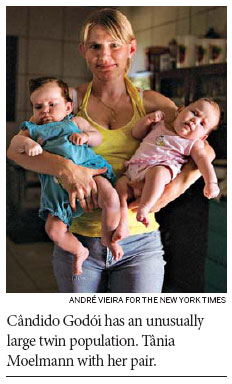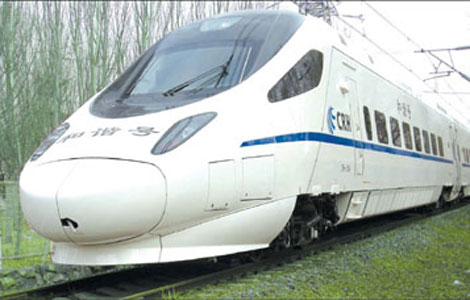Top News
In Brazil, a rogue gene and a boom in twins
Updated: 2011-04-24 08:05
By Alexei Barrionuevo and Myrna Domit (New York Times)
 |
SANTIAGO, Chile - For years, so many twins have been born in the small southern Brazilian town of Candido Godoi that residents wonder whether something mysterious lurks in the water, or even if Josef Mengele, the Nazi physician known as the Angel of Death, conducted experiments here.
But a group of scientists now says a series of DNA tests conducted on about 30 families found that a specific gene in the population of Candido Godoi appears more frequently in mothers of twins than in those without. The phenomenon is compounded by a high level of inbreeding among the population of mostly German-speaking immigrants, she said.
"We analyzed six genes and found one gene that confirms, in this population, a predisposition to the birth of twins," said Ursula Matte, a geneticist in Porto Alegre, Brazil.
She was the first to document that the rate of twin births in the town was unusually high. It was especially high in Sao Pedro, a village of about 350 that is part of Candido Godoi. Dr. Matte found that from 1990 to 1994, 10 percent of the births in Sao Pedro were twins, compared with less than 1 percent for Brazil as a whole.
The high concentration of twins has stirred outlandish theories. Residents say Mengele moved around southern Brazil in the 1960s, posing as a veterinarian, at about the time the twin births were thought to have taken off.
Mengele, who died in Brazil in 1979, was notorious for his often-deadly experiments on twins at Auschwitz, ostensibly in an effort to produce a master Aryan race.
But the study led by Dr. Matte analyzed 6,615 baptism certificates dating back 80 years and found that the twins phenomenon existed in the 1930s, "long before Mengele," she said. "We immediately disproved any involvement with Mengele."
Her team also analyzed the water supply - residents believe a mysterious mineral may be responsible for the high rate of twins - and found no abnormalities.
Daniela Junzvier, the culture coordinator at the mayor's office, said the city supported the study. "They have great hopes of finding out why they have so many twins, and to better understand what is behind their story," he said.
The scientists confirmed that the highest concentration of twins has been in Sao Pedro, with 33 pairs out of 436 births from 1959 to 2008, all living in a 2.4-square kilometer area.
In Sao Pedro, the team analyzed last names and conducted genetic tests. "With a small population of about 80 families, it was a challenge to find women that did not have twins within a first-degree relation," Dr. Matte said.
The scientists believe that a small number of immigrant families living in Sao Pedro may have brought the variant gene to the region. "This does not mean that it is a universal gene," Dr. Matte said. "If I take twins from New Zealand and test them, it will probably generate a different result."
The New York Times
E-paper

Blowing in the wind
High-Flyers from around the world recently traveled to home of the kite for a very special event.
Image maker
Changing fortunes
Two motherlands
Specials

Urban breathing space
City park at heart of Changchun positions itself as top tourism attraction

On a roll
Auto hub Changchun also sets its sight on taking lead in railway sector

The stage is set
The Edinburgh International Festival will have a Chinese flavor this year.
